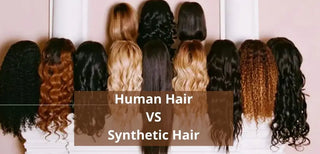When it comes to the world of hair extensions, wigs, and weaves, one of the most important decisions you'll make is choosing between real human hair and synthetic hair. Each type of hair has its pros and cons, and the best choice for you depends on your preferences, needs, and budget. But how can you distinguish real human hair from synthetic hair? In this comprehensive guide, we'll explore the key differences between real human hair and synthetic hair and provide tips to help you identify each type with confidence.
The Characteristics of Real Human Hair and Synthetic Hair

▶ Real Human Hair
Real human hair is harvested from human donors and is considered the highest quality option for hair extensions, wigs, and weaves. It offers a natural look and feel and can be styled, dyed, and treated just like your own hair. Some key features of real human hair include:- Natural texture and luster
- Can be heat-styled, colored, and chemically treated
- Blends seamlessly with your existing hair
- Long-lasting with proper care
- More expensive than synthetic hair
▶ Synthetic Hair
Synthetic hair is made from man-made fibers designed to mimic the appearance of real human hair. It is more affordable than real human hair but lacks the versatility and longevity of its natural counterpart. Some key features of synthetic hair include:- Uniform texture and shine
- Cannot be heat-styled or colored without damaging the fibers
- May not blend as seamlessly with your existing hair
- Less durable than real human hair
- More affordable than real human hair
▼For the most part, a natural human hair is a better choice for wigs despite it will be a little harder to collect. If you are confused at the judgment of the material when considering for purchase, there are some ways following to help you.
1. Appearance and Texture

One of the first clues to help you distinguish real human hair from synthetic hair is the appearance and texture. Real human hair has a natural luster and texture that can vary from donor to donor, while synthetic hair tends to have a uniform, overly-shiny appearance that can look less authentic. Additionally, real human hair can be styled and blended easily with your existing hair, whereas synthetic hair may not blend as seamlessly.
2. The Burn Test

The burn test is a simple yet effective method to distinguish real human hair from synthetic hair. To perform the burn test, carefully remove a few strands of hair from your extensions, wig, or weave and burn them with a lighter or match. Observe the reaction and smell the resulting smoke:
- Real Human Hair: It will burn slowly, producing a light, white smoke and a distinctive smell similar to burnt hair. The burnt hair will turn into ashes that can be easily crushed.
- Synthetic Hair: It will burn quickly and produce black smoke with a strong, acrid odor similar to burning plastic. The burnt hair will form a hard, sticky mass.
Always use caution when performing the burn test and never attempt it on a hairpiece that is being worn or is near your face.
3. The Heat Styling Test
One of the key differences between real human hair and synthetic hair is their ability to withstand heat styling. Real human hair can be heat-styled without damage, while synthetic hair can melt or become severely damaged under high heat. To perform the heat styling test, apply a heated styling tool (such as a flat iron or curling iron) to a small, inconspicuous section of the hair:
- Real Human Hair: The hair will respond to the heat styling as your natural hair would, without melting or becoming damaged.
- Synthetic Hair: The hair may melt, become sticky, or lose its shape under the heat.
Always start with a low heat setting and gradually increase the temperature if needed to avoid damaging the hair during the test.
4. The Coloring Test
Another way to distinguish real human hair from synthetic hair is by attempting to color the hair. Real human hair can be dyed with relative ease, while synthetic hair cannot be dyed without causing damage. To perform the coloring test, apply a small amount of hair dye to an inconspicuous section of the hair and observe the results:
- Real Human Hair: The hair will absorb the dye and change color.
- Synthetic Hair: The hair will not absorb the dye, and the color will remain unchanged.
Please note that this test may not be suitable for all hair types, and it's essential to follow the manufacturer's instructions for coloring hair extensions, wigs, and weaves.
5. The Price Test
Finally, one of the most straightforward ways to distinguish real human hair from synthetic hair is by comparing the price. Real human hair is more expensive than synthetic hair due to the higher quality and durability of the natural fibers. If you find a hairpiece that seems too good to be true in terms of price, it's likely synthetic hair.
In conclusion, distinguishing real human hair from synthetic hair may require a combination of observation and testing. By considering the appearance, texture, burn test results, heat styling test results, coloring test results, and price, you can confidently identifythe type of hair you're dealing with. Ultimately, the choice between real human hair and synthetic hair comes down to your individual preferences, needs, and budget. By understanding the differences between these two types of hair and knowing how to identify them, you can make an informed decision and enjoy a hairpiece that meets your expectations and enhances your overall look.

